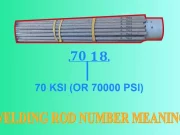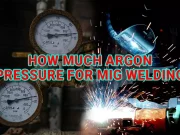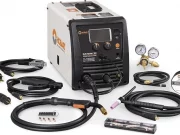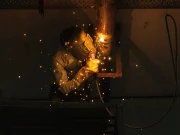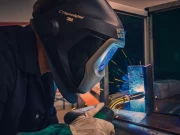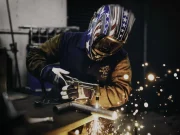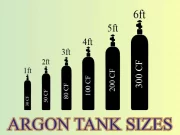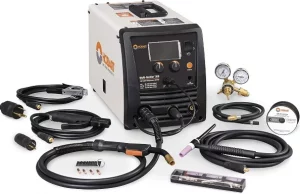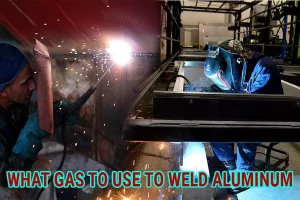
Welding is simply a fabrication process. Here two or more parts are joined together using pressure, heat, or both – the parts stick as they cool. Welding is common on thermoplastics and metals, but sometimes you can use it on wood.
Different materials need specific techniques and processes. Popular metal types in welding are aluminum, cast iron, and steel.
Aluminum is usually a relatively soft metal in its pure form and has several uses. However, it needs additional alloys for better strength.
Aluminum properties hugely vary from steel, and thus, working with it can be quite challenging. Challenges include sensitivity and distortion to heat input.
In aluminum welding, you have to follow the proper procedures and use the right equipment for a better outcome. The article answers the common questions among welders.
What Gas to Use to Weld Aluminum?
You can use argon and helium to weld aluminum – the gases can be in pure form or mixed. Pure argon is popular as shielding gas for aluminum welding, while pure argon is for thick sheets of about 12.5mm.
Note that helium has much higher thermal conductivity and ionization potential than argon. Helium produces much heat at higher temperatures in welding.
Mix argon with helium for higher temperatures if you work on thicker aluminum. The mixture proportion will vary depending on the material.
Why Is Aluminum Welding Difficult?
Aluminum is a popular fabrication metal. People love it because it’s eye-catching, lightweight, and non-corrosive.
The properties make it the ideal metal choice for various welds.
However, the properties that make it desirable also make it difficult to work with. There are several reasons why aluminum is hard to work with. In this section, there’s a list of the most popular ones.
Exposure of aluminum to ambient temperature leads to forming a wafer-thin layer known as aluminum oxide. Therefore the metal will appear silver-grey.
Amazing this property makes aluminum corrosion-resistant oxygen, water, and other chemicals. You’ll have to break the layer to prevent the weld pool and arc from having a connection during welding.
Note that breaking the aluminum oxide using welding heat might lead to extreme metal melting after aluminum oxide. In simple terms, you need to remove aluminum oxide before starting welding.
Aluminum welding involves working with different thicknesses. As a welder, you should learn to work with thinner materials – avoid burning them.
Again you need to penetrate thick material to have a strong weld adequately. Generally, aluminum is quite sensitive and easily contaminated with water, air, and dirt during the welding process.
If you shield it poorly or excessively long arcs, air will reach the weld and contaminate it. Oxygen is known to reduce aluminum ductility, oxide formation, and strength.
Therefore it complicated multi-pass welding and also affected the appearance of the metal. Overall it’s advisable always to clean aluminum and correctly store it before welding.
Aluminum absorbs hydrogen quicker in a molten state, and the more it heats up. However, the hydrogen usually separates as the metal solidifies. In the process, it can leave bubbles in the material, making aluminum weak and porous.
Oxide Removal
The removal of oxide from aluminum before the welding process is crucial. It’s because the melting temperature of the oxide is twice that of aluminum. The joints won’t perfectly fit together if you don’t remove the oxide.
Therefore it’s advisable to always clean your aluminum before welding it. You can use an aluminum wire brush – restrain from using a steel brush because it will contaminate the aluminum. Properly brush the aluminum part that you want to weld, and you’ll be good to go.
In MIG welding mild steel, the wire stick-out should be shorter. The wire stick-out is simply the wire amount extending past the MIG nozzle when welding.
The spray transfer method is common in aluminum MIG welding, which gets much hotter. Therefore the stick-out needs to be longer, about ¾ inch to 1 inch.
Types Of Aluminum Welding
If you are wondering how to deal with aluminum – you should know several welding processes that work with aluminum, such as:
- GTA/TIG welding
- GMAW/MIG welding
GTA/TIG
It’s one of the most common welding processes for aluminum. The process is more popular among welders and automotive enthusiasts for the professional racing teams.
It needs equipment with constant current and should be capable of using 100% argon as shielding gas.
However, the welder will have to keenly control the process by simply feeding the puddle with the filler material. The best part is the process is clean.
Alternating currents clean off the aluminum oxidized layer and prevent further contamination. There are many powerful and efficient TIG welder machines.
GMAW/MIG
It’s known as gas metal arc welding, and others popularly refer to it as (MIG) inert metal gas and are quite common in aluminum welding. MIG welding is known for its higher deposition rates and faster travel speeds than TIG.
However, the welder will have to utilize a push-pull gun or spool gun for wire feeding since it lacks a mechanical wire feeding system.
To avoid porous aluminum, ensure the filler rod and base material are moisture-free, clean, and have proper shielding gas coverage. Using pure argon as the gas shield is advisable.
Welding Technique
Welding is done after proper preparation, preheating, and fluxing of the material. You pass the flame in small circles over the starting point. Ensure the flux melts.
Scrap the filler rod over the toe surface for three to four seconds. Each time, the filler rod should come out of the flame clear.
Flaming action will help you know the right time to start welding without overheating the aluminum.
Melt the base metal before applying the filler rod. It’s advisable to do forehand welding on aluminum – the frame preheats the areas you want to weld. There’s no need for torch movement; progress forward.
For the material of thickness 4.8 mm and above, the torch needs to be in a uniform lateral motion. It allows proper distribution of weld metal over the entire weld width.
To perfectly remove the oxide, a slight forth and back motion hugely help in the flux. Periodically dip the filler rod into the weld puddle and withdraw it in a forward motion.
The withdrawal method prevents porosity, closes the puddles, and helps flux in oxide film removal.
Travel Speed
When it comes to aluminum MIG welding, it’s advisable to use a similar voltage setting to mild steel. However, it would be best if you doubled your travel speed.
When dealing with aluminum, you will have to move uncomfortably first with the MIG gun – however, you’ll get used to it with time.
The MIG welding circuit transfer process is short, and it means there will be short circuits at the joint by the wire electrodes.
You will experience a molten weld puddle. In aluminum welding, you will mostly use spray transfer. The spray transfer method means spraying tiny aluminum particles on the weld puddle.
It’s a simple process that most MIG welders can handle. Overall you need to know how to use the correct gas mixture and boost the voltage.
Shielding Gas Selection
In aluminum welding, shielding gas is a necessity. People usually select a particular gas because of its cost, ease of use, and heat-input needs.
Aluminum metal is unique and has distinctive requirements. Aluminum thermal conductivity is unique because heavier and thicker sections need high heat input to join perfectly.
However, other people love adding helium to normal shielding gas. For example, adding helium to 100% argon – makes the constant current power give different voltage.
In return, it produces more heat. Mixing gases will produce outstanding results, but you will spend more.
Note that helium is more expensive than argon; therefore, if you add significant helium amounts of about 50% or 75%, then it’ll be expensive.
In recent years there has been high helium demand globally. It’s because the gas has several applications, but still, its availability is so tight. High demand and its scarcity make it quite expensive.
They enjoy helium’s benefits at a low cost, and you should use small amounts of nitrogen gas. It will deliver the effects similar to adding helium to 100% argon.
Aluminum plus nitrogen creates aluminum nitrides that are so emissive. You also have to consider the purity of shielding gas.
Poor gas quality will quickly contaminate the weld – the gas quality standards should be so high when it comes to aluminum.
Metals You Can Weld To Aluminum
If you weld other metals like magnesium, copper, steel, or titanium to aluminum, it leads to brittle intermetallic compounds.
You can, however, avoid the brittle compounds using several special techniques. The techniques isolate molten aluminum from other metals in the welding process.
Conclusion
The gas welding process is common on aluminum, a very popular metal. There are several aluminum welding processes which are MIG and TIG welding.
Each has its requirements and procedures. The most popular welding gases for aluminum are pure helium and pure argon or their mixture.




